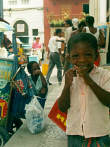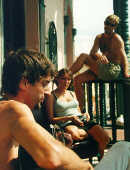While walking along the narrow streets of Cartagena, I could not stop thinking that time had indeed stopped here. I passed by the stores with furniture so old that it would have easily remembered my grandparents’ years; I glanced inside the barbershops with the interior resembling a pre-WWII Europe, to see people nap innocently in their chairs, sunken profoundly in the afternoon siesta. As I watched with great interest older people in the many of Cartagena’s charming squares and plazas, ceaselessly repeating the routine of chess and conversation, I bowed down in respect and admiration for I found their ways so timeless and fulfilling of human behavior.
When the sun finally set over Old Cartagena, the streets began to liven up. The magical and somnolent vibe gave way to yet another dimension of the city. Encouraged by the fresh evening breeze, people appeared in the streets first by dozens, later by hundreds and hundreds, until the quarters bustled with jovial crowds of homies and tourists.
Doing little to defy my weakness, I paid particular attention to girls whom I found of extraordinary elegance and beauty. Colombian women are as diverse as the peoples and races that marked their presence in this part of the Caribbean. By blending together in the course of centuries, today’s residents of Cartagena come in all shades of skin color, from light-skinned, brown, to very dark. This seems to benefit women in particular who can be of extraordinary appeal and beauty. If you are male and in your prime years, you will find out for yourself that there is nothing else so troublesome to harness as your hormones let loose in the streets of Cartagena.

With the businesses opening in the late afternoon, the streets resonate with music of the Caribbean. The sounds of salsa pounds from every direction as if competing for audience. In the absence of noise limits in Cartagena (because they would contradict the character of the people) businesses are like mini radio stations, playing their favorite selections without ado. Nearly every person trading in the streets, from a shoeshine boy to a fruit seller, is equipped with a radio or tape player blasting jovial melodies.
I discovered that smoking a joint in the park before venturing further into the streets added to my understanding of this absolute chaos. Behind the maze of food stalls, small businesses, countless crowds of people, and the unstoppable stream of music unfolded a well-defined, intoxicating fabric of society. Cartagena pulled me towards its center of gravity with its irresistible force, making me consider staying here for good. However, how do you stay in Colombia with the little money you hide in the money-belt?
The answer is cocaine, the primary crop and export of Colombia. I saw people driven to madness by overuse of ‘coke’ and persons who bet their future on smuggling it safely across the border. But I had never met a guy who went as far as playing the tune to both activities at once. It was in Hotel Familiar that I met Andrea, a 30-year-old Italian, who briefly stirred my internal peace with his perilous visions. It turned out that I was not the first and only one who had ever considered living in this city.
You could call Andrea a veteran of travels to Colombia. He abandoned Italy to seek sanity in the wrong country. A carpenter in Genoa, Andrea fell in love with the city during his first trip to Colombia a few years back. Since then he returned here at every opportunity. It is for someone else to decide whether it was the allure of the city, the potency of cocaine, or the combination of both that induced Andrea’s attachment. However, he was heavily addicted to ‘coke’, snorting 3 grams on a daily basis. The bone in his nose lost its structure, becoming as flexible as rubber. He ended up burning and inhaling the drug.

Behind his addiction, Andrea was a most talented and personable guy. He traveled with his guitar and could sing some real tunes. He composed songs in Italian and even though I didn’t understand much, I enjoyed sitting for hours by his side, listening to the ballads from the Mediterranean. He confided in me that his life had felt inert in Italy until he arrived in Cartagena. With every visit (and he’s been to Colombia more than you have), he began to consider it his home, weaving plans to settle down within the old walls.
Read the whole adventure!
Part One
Part Two
Part Three